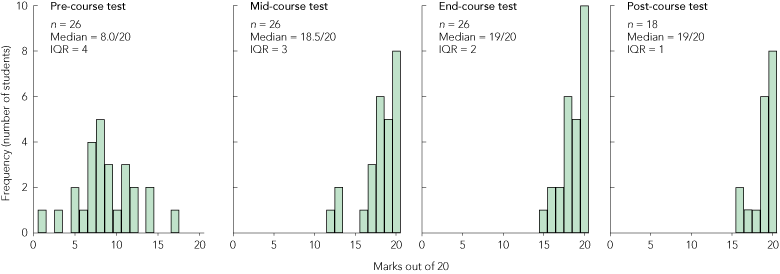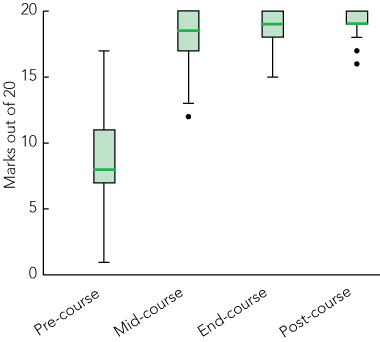Anatomy of the human body has been taught to medical students by dissection of embalmed, donated cadavers for centuries.1 Until recent decades, this has been a rite of passage for medical students, delivering fundamental regional, relational and topographical anatomical knowledge,2 together with tactile gnosis (ie, what various human tissues feel like)3 and dissection heuristics (ie, tissue-handling techniques).4 It has also helped junior medical students deal with issues surrounding death.5
However, over the past several decades, despite the protestations of many, the teaching of anatomy by dissection has gradually decreased.6-9 As more and more essential educational material has been packed into medical school curricula, time-consuming anatomical dissection has fallen by the wayside. This has led to a wide variation in the amount of anatomy taught at Australian and New Zealand medical schools.2,10
The surgical community and other clinicians associated with the University of Sydney soon became very concerned, as the lack of anatomical knowledge of students reaching the clinical years made the teaching of clinical medicine and surgery generally very difficult.8 Student surveys in 1998, 1999 and 2006 revealed widespread dissatisfaction with anatomy teaching (University of Sydney, Faculty of Medicine: preparation for hospital practice questionnaire results, 1998 and 1999; and University of Sydney Medical Program Year 3 curriculum survey, 2006).
A review of the University of Sydney Medical Program was undertaken in 2007.11 Following representations from numerous individuals and groups, including students, the review report recommended the “strengthening” of anatomy teaching. This led to a trebling of the total hours of anatomy teaching in Medicine 1 and 2 (the first 2 years of the graduate medical program) from 50.5 to 152.5 hours (since expanded to 170.5 hours) (Deborah Bryce, Senior Lecturer, Discipline of Anatomy and Histology, University of Sydney, personal communication).
The course was first conducted in 2009, when it was very favourably evaluated by the Office of Medical Education of the University of Sydney.12 This article analyses the results of the 2010 course.
Acceptance of students into the elective “Anatomy by whole body dissection” course was on a first-come-first-served basis, with a maximum of 32 places offered. The dissection course was based on the classical Cunningham’s manual of practical anatomy, volumes 1 to 3.13 Dissection schedules were drawn up in colour-coded spreadsheet form to cover each of the 34 days of dissection. Each day’s schedule listed the area to be dissected, the required prereading of the texts, and the dissection tasks to be carried out that day, clearly outlined. The actual dissection instructions were transcribed onto laminated colour-coded cards. All diagrams in the manuals were projected and displayed on four large central console screens. Surgical-quality instruments were provided so that dissection could be carried out at a rapid pace in this intense full-time course.
Sixteen surgical trainees were appointed as anatomy demonstrators for the course. At any one time, eight or more of these trainees circulated continuously, acting as dissection demonstrators. A group of 20 surgical colleagues and other senior anatomists volunteered their services as supervisors. Supervisors were present each day, especially for their areas of expertise. This emphasised the clinical aspects of the areas being dissected. All demonstrators and supervisors acted in a pro bono capacity.
Student assessments were by a standardised practical examination. Each assessment consisted of four prosected wet specimens. Each student had to identify accurately five labelled structures on each specimen. Assessments were carried out before, during and at the end of the course, and a post-course assessment was administered 1 month after completion of the course.
The results of each assessment were collated and analysed statistically. The primary outcome measure was the assessment test score (each test was marked out of 20). Statistical analyses examined the effect of test time point (pre-course, mid-course, end-course or post-course) on student test scores. The data were normally distributed at baseline, but significantly skewed at each subsequent time point. Consequently, measures of central tendency for assessment scores are presented as medians with interquartile ranges (IQRs). The analyses compared scores from consecutive time points to examine whether there was an initial improvement (from pre-course to mid-course scores) and if so, whether there was maintenance of improvement (from mid-course to end-course and then from end-course to post-course scores). Because of the significant skew to the distribution of scores subsequent to the pre-course test, non-parametric techniques were employed. The Wilcoxon signed-rank test was used for all comparisons. To explore the possible bias resulting from scores missing in the post-course data, a sensitivity analysis was conducted using a worst-case imputation. SPSS version 17.0 (SPSS Inc, Chicago, Ill, USA) was used to conduct all analyses and P < 0.05 was considered statistically significant.
In 2010, 29 students participated in the course. Three students of the 29 enrolled in this course did not attend the pre-course assessment and were excluded from our analysis. All 26 students who participated in the pre-course assessment also took part in the mid-course and end-course assessments. Eighteen of these students took part in the post-course assessment 1 month after the end of the dissection course. The histograms in Box 1 show the distribution of marks (out of a maximum of 20) scored in each assessment. The median pre-course assessment score was 8/20 (IQR, 4) and the subsequent median test scores were 18.5/20 (IQR, 3), 19/20 (IQR, 2) and 19/20 (IQR, 1) in the mid-course, end-course and post-course assessments, respectively. These test scores are also represented in Box 2, which shows the median test scores plus the IQR for each of the four assessment time points as well as minimum and maximum values and outliers.
All 29 students in the dissection course completed an anonymous questionnaire at the end of the course. There were 21 males and 8 females in the group (mean age, 26.4 years [SD, 3.7 years]; range, 23–40 years). All students held a prior degree, including degrees in arts, dentistry, engineering, law, pharmacy and science. Eighteen students identified themselves as having no prior anatomical teaching other than in Years 1 and 2 of the University of Sydney Medical Program. All 29 students perceived deficient anatomical knowledge to be their main reason for participating in this elective course. Twenty-five students also mentioned an interest in a possible surgical career as a complementary reason.
teaching methods, resources and supervision;
dissection manuals, projected images and laminated instructions;
teaching by surgical trainees and supervisors;
frequent practical assessments; and
teaching anatomy by dissection within a clinical context.
methodical dissection leading to the acquisition of anatomical knowledge with an appreciation of relations between structures (22);
the development of a three-dimensional mind map of the various anatomical regions (8);
anatomical information being put in a clinical context by demonstrators and supervisors (15); and
the presence of supervisors teaching clinical anatomy in their area of expertise to small groups (14).
Students found the least favourable features of the course to be:
Opinion on the importance of gross topographical human anatomy in medical education ranges from those who believe it is the basis of all medical knowledge14 to those who feel that such anatomical knowledge is superfluous. There is abundant evidence that medical students appreciate that a good basic knowledge of human anatomy is essential to safe and sound medical practice, even if this is not fully appreciated by some of the writers of their respective curricula.15
The universal approval of this anatomy dissection course by the participants, together with their recommendation that it should be available to all students, indicates a perception that anatomical instruction is currently deficient and that dissection should be reintroduced to some degree into the regular medical curriculum. This consideration is supported by a number of commentators.15-18 It must be acknowledged that these students were highly motivated and their enthusiasm may not be shared by all of their peers. The strong approval of the course would indicate that it is a time-effective way to impart clinical anatomical knowledge in the shortened 4-year modern medical curriculum — a conclusion supported by others.19,20
The concept of the three-dimensional relational mind map of the regions of the human body is not new (Norman Eizenberg, Professor, Department of Anatomy and Developmental Biology, Monash University. Melbourne, personal communication). However, many students remarked that this concept, best imparted by anatomical dissection, produced a clarity of understanding of regional relational anatomy not appreciated before.19,21
The poor performance of this cohort of students in the pre-course assessment was a matter of concern, especially as all members of the group were just 12 months away from provisional registration as medical practitioners. Only nine of the 26 students managed to correctly answer at least half of the 20 questions asked (ie, reached a 50% pass mark). Almost 25% of the total answers were considered to be answers of concern, indicating a perfunctory knowledge of gross human anatomy. This occurred despite the fact that this was a group of students expressing an interest in anatomy, with a majority considering a surgical career. It must be noted that this cohort of students had not been fully exposed to the “strengthened” anatomy course recommended by the 2007 review of the University of Sydney Medical Program.11
There are a number of reports in the medical literature of patient misadventure due to inadequate anatomical knowledge, many involving damage to adjacent structures.22-25 The medicolegal aspect of such errors makes the question of how much anatomical knowledge is necessary for safe medical practice of great importance. With the recorded wide variation in the amount and standard of anatomical instruction currently practised in Australian and New Zealand medical schools,2,10 there is an apparent need for the introduction of a standard basic national curriculum in gross human anatomy.26 Such a curriculum has been formulated for North America.14 The new curriculum should include dissection anatomy as a significant component and have a barrier assessment (ie, an assessment that halts progress in the course until satisfactorily completed). This would ensure that medical graduates have a reasonable knowledge of gross human anatomy and are equipped to properly understand the amazingly complex biological structure with which most of them will be intimately concerned throughout the rest of their professional careers.
After our experience with this dissection course, we agree with a recent United Kingdom report that:
[A]natomy should remain a principal component of medical education, with dissection as its core teaching method. Further collaboration between surgeons and anatomists should strengthen a naturally close and mutually beneficial relationship.17
1 Dissection course: test histograms for pre-course, mid-course, end-course and post-course assessments
 |






Abstract
Objective: To evaluate the 2010 “Anatomy by whole body dissection” course, a 7-week elective course offered to senior medical students at the University of Sydney at the end of their third year.
Design, setting and participants: In the 2010 course, 29 students divided into eight groups carried out whole-body dissections on eight cadavers over a 34-day period. Surgical trainees acted as demonstrators, and surgeons and anatomists as supervisors. The students were assessed by practical tests involving the identification of 20 tagged structures in four wet specimens before, during, at the end of, and 1 month after the course. In addition, students were asked to complete an anonymous feedback questionnaire about the course.
Main outcome measure: Acquisition of topographical anatomical knowledge, and student feedback on the usefulness of the course.
Results: A significant increase in topographical clinical anatomical knowledge was demonstrated among the participants and was maintained in the short term. The median pre-course assessment score was 8/20 (interquartile range [IQR], 4) and the median post-course assessment score was 19/20 (IQR, 1). This difference was statistically significant (P < 0.001). All students rated the course as “very good”, and unanimously recommended that the course be available to all students as part of the medical curriculum.
Conclusion: Students’ knowledge of anatomy improved significantly between the pre-course and post-course assessments, and all students rated the course very favourably. This supports our view that dissection anatomy should be an integral component of medical education.